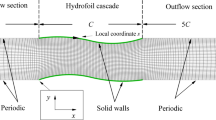Abstract
Prandtl’s lifting line theory was generalized to the lifting problem of a three-dimensional hydrofoil in the presence of a free surface. Similar to the classical lifting theory, the singularity distribution method was utilized to solve two-dimensional lifting problems for the hydrofoil beneath the free surface at the air-water interface, and a lifting line theory was developed to correct three-dimensional effects of the hydrofoil with a large aspect ratio. Differing from the classical lifting theory, the main focus was on finding the three-dimensional Green function of the free surface induced by the steady motion of a system of horseshoe vortices under the free surface. Finally, numerical examples were given to show the relationship between the lift coefficient and submergence Froude numbers for 2-D and 3-D hydrofoils. If the submergence Froude number is small free surface effect will be significant registered as the increase of lift coefficient. The validity of these approaches was examined in comparison with the results calculated by other methods.
Similar content being viewed by others
References
Abramowitz M, Stegun IA (1972). Handbook of mathematical functions. Dover Publications, Dover, New York, 480–489.
Antonio C, Daniele D, Franco M (2005). Hydrofoil vibration induced by a random flow: a stochastic perturbation approach. Journal of Sound and Vibration, 283(1), 401–432.
Antoine D, Jacques AA, Francois D, Jean-Francois S (2009). Computational and experimental investigation of flow over a transient pitching hydrofoil. European Journal of Mechanics B/Fluids, 28(6), 728–743.
Bal S (1999). A potential based panel method for 2-D hydrofoils. Ocean Engineering, 26(4), 343–361.
Bal S (2005). Lift and drag characteristics of swept and V-type hydrofoils. International Journal of Maritime Engineering, 147(Part A), 51–64.
Bal S (2007). High-speed submerged and surface piercing cavitating hydrofoils, including tandem case. Ocean Engineering, 34(14), 1935–1946.
Bal S, Kinnas SA (2002). A BEM for the prediction of free surface effects on cavitating hydrofoils. Computational Mechanics, 28(3), 260–274.
Chung MH (2008). Numerical study of rowing hydrofoil performance at low Reynolds number. Journal of Fluid and Structures, 24(3), 313–335.
Faltinsen OM (2005). Hydrodynamics of high-speed marine vehicles. Cambridge University Press, New York, USA, 165–199.
Filippov SI (2001). Flow past a submerged hydrofoil. Fluid Dynamics, 36(3), 489–496.
Hough GR, Moran TP (1969). Froude number effects on two-dimensional hydrofoils. Journal of Ship Research. 13(1), 53–60.
Huang Sheng, He Miao, Wang Chao, Chang Xin (2010). Simulation of cavitating flow around a 2-D hydrofoil. Journal of Marine Science and Application, 9(1), 63–68.
Kang C, Yang MG (2007). Experimental Study of the Surface Wave around Hydrofoils. Proceedings of the Fifth International Conference on Fluid Mechanics, Shanghai, 379.
Kartikeya KM, Jeff L, Karman G, Urmila G (2006). Cavitating multiphase flow over oscillating hydrofoils. 44 th AIAA Aerospace Science Meeting and Exhibit, Reno, Nevada, AIAA Paper 2006-1310.
Katz J, Plotkin A (2001). Low-speed aerodynamics: from wing theory to panel method. McGraw-Hill Inc, New York, USA, 195–200.
Kim SH, Yamato H (2004). An experimental study of the longitudinal motion control of a fully submerged hydrofoil model in following seas. Ocean Engineering, 31(5), 523–537.
Kouh JS, Lin TJ, Chau, SW (2002). Performance analysis of two-dimensional hydrofoil under free surface. Journal of National Taiwan University, 86(10), 113–123.
Lan CT (1974). An improved nonlinear lifting-line theory. AIAA Journal, 11(5), 739–742.
Leroux JB, Coutier-Delgosha O, Astolfi JA (2005). A joint experimental and numerical study of mechanisms associated to instability of partial cavitation on two-dimensional hydrofoil. Physics of Fluids, 17(5), 052101–052101-20.
Newman JN (1977). Marine hydrodynamics. Cambridge University Press, New York, USA, 200–205.
Sarraf C, Djeridi H, Prothin S, Billard JY (2010). Thickness effect of NACA foils on hydrodynamic global parameters, boundary layer states and stall establishment. Journal of Fluids and Structure, 26(4), 559–578.
Voitkunskii YI (1977). Ship Resistance. Beijing Science Press, Beijing, China, 425–430. (in Chinese)
Xie N, Vassalos D (2007). Performance analysis of 3D hydrofoil under free surface. Ocean Engineering, 34(8), 1257–1264.
Zhao Lianen, Xie Yonghe (2009). The principle and design of high performance ships. National Defense Industry Press, Beijing, 411–421. (in Chinese)
Author information
Authors and Affiliations
Corresponding author
Additional information
Foundation item: Supported by the National Natural Science Foundation of China under Grant No.50921001 and 973 Program under Grant No. 2010CB83270.
Hui Liang, born in 1988, is currently an undergraduate student at the School of Naval Architecture Engineering, Dalian University of Technology. His research interests include hydrodynamics, aerodynamics and fluid-structure interaction.
Zhi Zong, born in 1964, is a professor at Dalian University of Technology. His research interests are hydrodynamics, underwater explosion and fluid-structure interaction. He authored two monographs in English published by Elsevier Science in 2006 and CRC Press in 2009, respectively.
Rights and permissions
About this article
Cite this article
Liang, H., Zong, Z. A lifting line theory for a three-dimensional hydrofoil. J. Marine. Sci. Appl. 10, 199–205 (2011). https://doi.org/10.1007/s11804-011-1038-5
Received:
Published:
Issue Date:
DOI: https://doi.org/10.1007/s11804-011-1038-5




